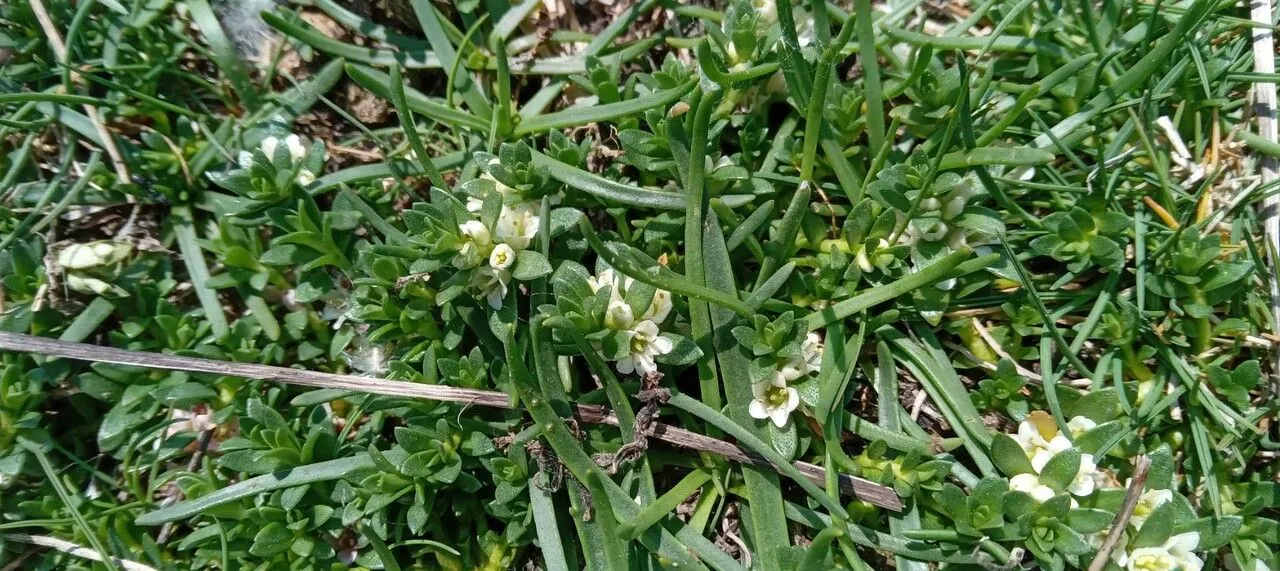
Author: (L.) Galasso, Banfi & Soldano
Bibliography: Atti Soc. Ital. Sci. Nat. Mus. Civico Storia Nat. Milano 146: 229 (2005)
Year: 2005
Status: accepted
Rank: species
Genus: Lysimachia
Vegetable: False
Observations: Temp. Northern Hemisphere
Black saltwort, scientifically named Lysimachia maritima, is a fascinating plant predominantly found across the temperate regions of the Northern Hemisphere. This species belongs to the Primulaceae family, a well-known family that encompasses a wide range of flowering plants.
The discovery and classification of Black saltwort were detailed in a publication by the Italian Society of Natural Sciences and the Civic Museum of Natural History of Milan. This significant work, compiled in 2005 by renowned botanists Galasso, Banfi, and Soldano, has played a critical role in our understanding of the plant’s taxonomy and ecological preferences.
Characteristically, Black saltwort thrives in coastal habitats, where it often endures saline conditions, hinting at its common name. The plant’s resilience in such environments illustrates its adaptation strategies, making it a subject of interest for studies on plant ecology and environmental stress tolerance.
The morphology of Lysimachia maritima is notable for its succulent-like leaves, which serve as a water storage mechanism, enabling the plant to survive in dry, saline soils. The flowers of Black saltwort are typically small and unassuming but contribute to the overall biodiversity of coastal ecosystems.
In addition to its ecological importance, Black saltwort is often studied for its potential benefits in soil stabilization and habitat restoration, particularly in areas affected by high salinity. Understanding and preserving such species is crucial, as they play an integral role in maintaining the health and stability of their native environments.
Ultimately, Lysimachia maritima serves as a remarkable example of plant adaptation and resilience, offering insights into the complex interplay between flora and their habitats. The work spearheaded by Galasso, Banfi, and Soldano remains a valuable resource for botanists and ecologists who continue to explore the wonders of plant life in the Northern Hemisphere.
Deu: milchkraut
Dan: sandkryb
Eng: sea milkwort, saltwort, sea-milkwort, black saltwort
Fin: merirannikki
Swe: merirannikki, strandkrypa
Nob: strandkryp
Nno: strandkryp
Fra: glaux maritime, glauce maritime, glaux
Sme: gáddenjomot
En: Black saltwort, Sea milkweed, Sea milkwort, Saltwort, Sea-milkwort
Cs: Sivěnka přímořská
Da: Sandkryb
Nl: Melkkruid
Et: Rannikas
Fi: Merirannikki
Fr: Glaux maritime, Glauce maritime, Glaux, Herbe au lait
De: Salz-Milchkraut, Salzmilchkraut, Strand-Milchkraut, Strandmilchkraut, Milchkraut
Ga: Lus an tsailte
Kk: Етжапырақ
Lt: Pajūrinė pienažolė
Se: Gáddenjomot
Nb: Strandkryp
Nn: Strandkryp
Fa: شبدر شور
Pl: Mlecznik nadmorski
Sv: Strandkrypa, Merirannikki
Tr: Deniz süt otu
Cy: Glas yr heli
© copyright of the Board of Trustees of the Royal Botanic Gardens, Kew.
© copyright of the Board of Trustees of the Royal Botanic Gardens, Kew.
© copyright of the Board of Trustees of the Royal Botanic Gardens, Kew.
Taken May 8, 2022 by Fabrice Rubio (cc-by-sa)
Taken Jun 13, 2017 by Albert V. (cc-by-sa)
Taken Jul 5, 2018 by Tela Botanica − Liliane Roubaudi (cc-by-sa)
Taken Jul 5, 2018 by Tela Botanica − Liliane Roubaudi (cc-by-sa)
Taken Jul 5, 2018 by Tela Botanica − Liliane Roubaudi (cc-by-sa)
Taken Jun 24, 2016 by Tela Botanica − Florent BECK (cc-by-sa)
Taken Jun 24, 2016 by Tela Botanica − Florent BECK (cc-by-sa)
Taken Sep 18, 2021 by S K (cc-by-sa)
Taken Sep 18, 2021 by S K (cc-by-sa)
Taken Jul 2, 2019 by Rebecca Lehmann (cc-by-sa)
Taken Jul 5, 2018 by Tela Botanica − Liliane Roubaudi (cc-by-sa)
Taken Jun 22, 2016 by Tela Botanica − Genevieve BOTTI (cc-by-sa)
Taken May 25, 2015 by Tela Botanica − Genevieve BOTTI (cc-by-sa)
Taken Jun 22, 2016 by Tela Botanica − Genevieve BOTTI (cc-by-sa)
Taken Jun 2, 2019 by Josef Hodek (cc-by-sa)
Taken Jul 15, 2008 by Photoflora – Benoit BOCK (©)
Taken Jun 13, 2003 by Cédric Jankowiak (cc-by-sa)
Taken May 23, 2022 by Pierre LEON (cc-by-sa)
Taken May 7, 2022 by Pierre LEON (cc-by-sa)
Taken May 15, 2009 by Photoflora – Jean-Luc TASSET (©)
Taken Jun 22, 2012 by Tela Botanica − Geneviève Botti (cc-by-sa)
Taken Jun 12, 2008 by Tela Botanica − Claude FIGUREAU (cc-by-sa)
Taken Jun 22, 2012 by Tela Botanica − Geneviève Botti (cc-by-sa)
Taken Jun 10, 2022 by wjgoe (cc-by-sa)
Growth form: Rhizomatous
Growth habit: Forb/herb
Growth rate: Moderate
Ph maximum: 7.5
Ph minimum: 7.0
Light: 8
Atmospheric humidity: 7
Soil nutriments: 5
Soil salinity: 5
Family: Myrtaceae Author: (F.Muell.) K.D.Hill & L.A.S.Johnson Bibliography: Telopea 6: 402 (1995) Year: 1995 Status:…
Family: Rubiaceae Author: Pierre ex A.Froehner Bibliography: Notizbl. Bot. Gart. Berlin-Dahlem 1: 237 (1897) Year:…
Family: Sapindaceae Author: Koidz. Bibliography: J. Coll. Sci. Imp. Univ. Tokyo 32(1): 38 (1911) Year:…
Family: Asteraceae Author: A.Gray Bibliography: Pacif. Railr. Rep.: 107 (1857) Year: 1857 Status: accepted Rank:…
Family: Fabaceae Author: Medik. Bibliography: Vorles. Churpfälz. Phys.-Ökon. Ges. 2: 398 (1787) Year: 1787 Status:…
Family: Aspleniaceae Author: (Cav.) Alston Bibliography: Bull. Misc. Inform. Kew 1932: 309 (1932) Year: 1932…